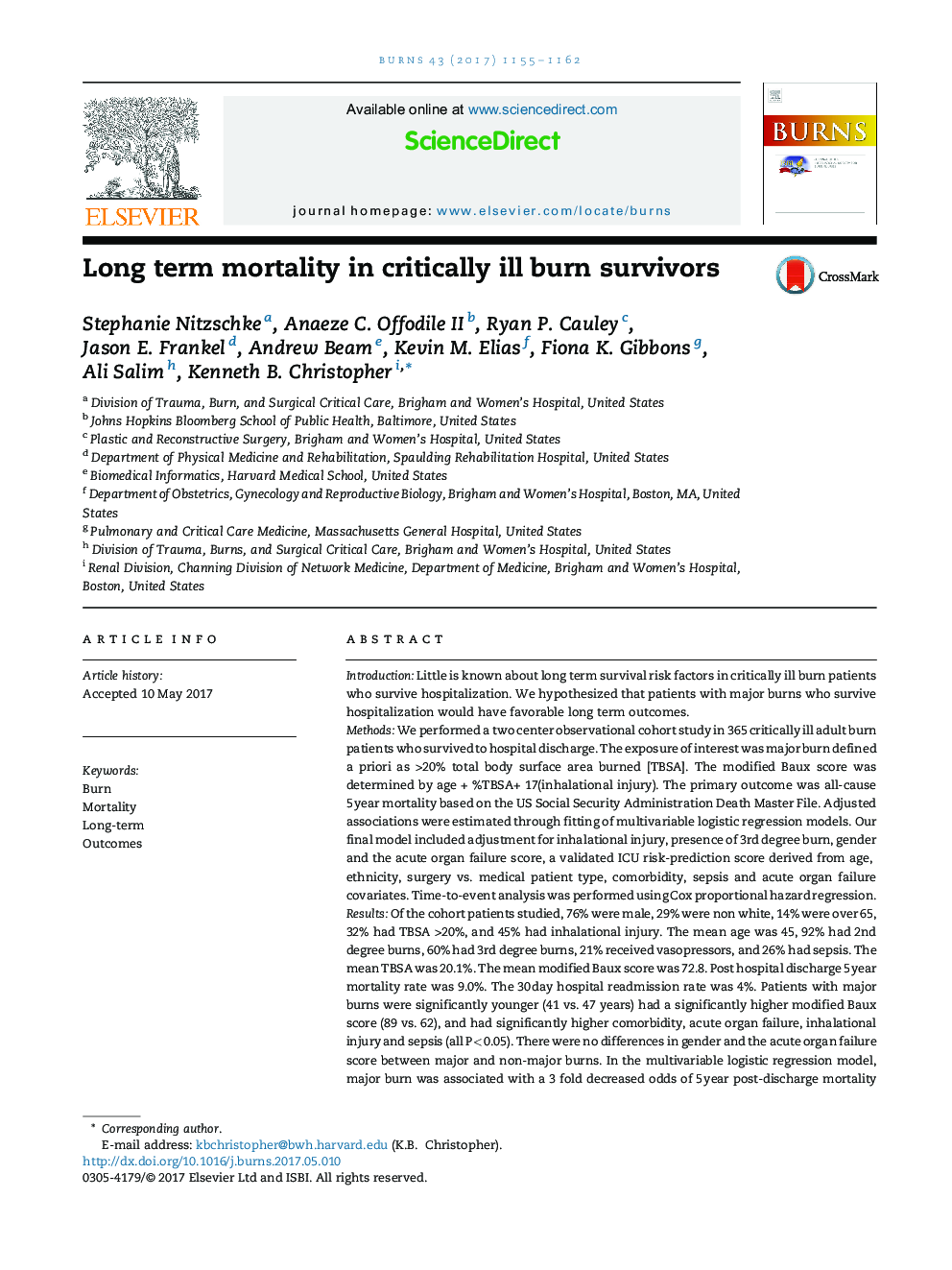| کد مقاله | کد نشریه | سال انتشار | مقاله انگلیسی | نسخه تمام متن |
|---|---|---|---|---|
| 5636053 | 1406661 | 2017 | 8 صفحه PDF | دانلود رایگان |
- Hospital survival in the critically ill burn patient is related to smaller burn size.
- Patients with major burns who survive hospitalization have favorable outcomes.
- The modified Baux score is not predictive for long term outcomes following discharge.
IntroductionLittle is known about long term survival risk factors in critically ill burn patients who survive hospitalization. We hypothesized that patients with major burns who survive hospitalization would have favorable long term outcomes.MethodsWe performed a two center observational cohort study in 365 critically ill adult burn patients who survived to hospital discharge. The exposure of interest was major burn defined a priori as >20% total body surface area burned [TBSA]. The modified Baux score was determined by age + %TBSA+ 17(inhalational injury). The primary outcome was all-cause 5 year mortality based on the US Social Security Administration Death Master File. Adjusted associations were estimated through fitting of multivariable logistic regression models. Our final model included adjustment for inhalational injury, presence of 3rd degree burn, gender and the acute organ failure score, a validated ICU risk-prediction score derived from age, ethnicity, surgery vs. medical patient type, comorbidity, sepsis and acute organ failure covariates. Time-to-event analysis was performed using Cox proportional hazard regression.ResultsOf the cohort patients studied, 76% were male, 29% were non white, 14% were over 65, 32% had TBSA >20%, and 45% had inhalational injury. The mean age was 45, 92% had 2nd degree burns, 60% had 3rd degree burns, 21% received vasopressors, and 26% had sepsis. The mean TBSA was 20.1%. The mean modified Baux score was 72.8. Post hospital discharge 5 year mortality rate was 9.0%. The 30 day hospital readmission rate was 4%. Patients with major burns were significantly younger (41 vs. 47 years) had a significantly higher modified Baux score (89 vs. 62), and had significantly higher comorbidity, acute organ failure, inhalational injury and sepsis (all P < 0.05). There were no differences in gender and the acute organ failure score between major and non-major burns. In the multivariable logistic regression model, major burn was associated with a 3 fold decreased odds of 5 year post-discharge mortality compared to patients with TBSA<20% [OR = 0.29 (95%CI 0.11-0.78; P = 0.014)]. The adjusted model showed good discrimination [AUC 0.81 (95%CI 0.74-0.89)] and calibration (Hosmer-Lemeshow Ï2 P = 0.67). Cox proportional hazard multivariable regression modeling, adjusting for inhalational injury, presence of 3rd degree burn, gender and the acute organ failure score, showed that major burn was predictive of lower mortality following hospital admission [HR = 0.34 (95% CI 0.15-0.76; P = 0.009)]. The modified Baux score was not predictive for mortality following hospital discharge [OR 5 year post-discharge mortality = 1.00 (95%CI 0.99-1.02; P = 0.74); HR for post-discharge mortality = 1.00 (95% CI 0.99-1.02; P = 0.55)].ConclusionsCritically ill patients with major burns who survive to hospital discharge have decreased 5 year mortality compared to those with less severe burns. ICU Burn unit patients who survive to hospital discharge are younger with less comorbidities. The observed relationship is likely due to the relatively higher physiological reserve present in those who survive a Burn ICU course which may provide for a survival advantage during recovery after major burn.
Journal: Burns - Volume 43, Issue 6, September 2017, Pages 1155-1162
